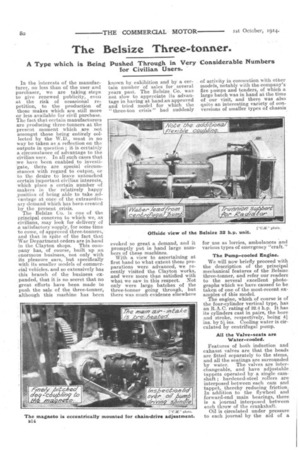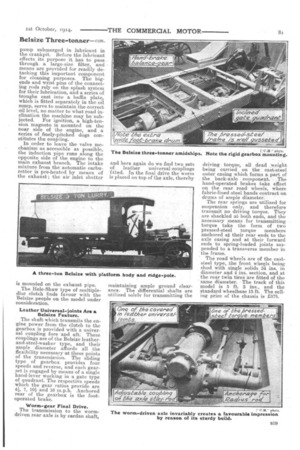The Belsize Three-tonner.
Page 6

Page 7

If you've noticed an error in this article please click here to report it so we can fix it.
A Type which is Being Pushed Through in Very Considerable Numbers for Civilian Users.
In the interests of the manufacturer, no less than of the user and purchaser, we are taking steps to give renewed publicity, eveu at the risk of occasional repetition, to the production of those makes which are still more or less available for civil purchase. The fact that certain manufacturers are producing three-tonners at the present moment which are not amongst those being entirely collected by the W.D., must in no way be taken as a reflection on the outputs in question ; it is certainly a circumstance of advantage to the civilian user. In all such cases that we have been enabled. to investigate, there are special circumstances with regard to output, or to the desire to leave untouched certain important civilian interests, which place a certain number of makers in the relatively happy .positian of being able to take advantage at once of the extraordinary demand which has been created by the present crisis.
The Belsize Co. is one of thr) principal concerns to which we, as civilians, may look for delivery of a satisfactory supply, for some time to come, of approved three-tonners, and that in spite of the fact that War Department orders are in hand in the Clayton shops. This company has, of course, built up an enormous business, not only with its pleasure cars, but E-pecifically with its smaller models of commercial vehicles, and so extensively has this branch of the business expanded, that it is no secret that no great efforts have been made to push the sale of the three-tonner, although this machine has been
known by exhibition and by a certain number of sales for several years past. The Belsize Co. wag not slow to appreciate its advantage in having at hand an approved and tried model for which the " three-ton crisis" had suddenly evoked so great a demand, and it promptly put in hand large numbers of these machines.
With a view to ascertaining at first hand to what extent these preparations were advanced, we recently visited the Clayton works, and were more than satisfied with what we saw in this respect. Not only were large batches of the three-tonner going through, but there was much evidence elsewhere of activity in connection with other models, notably with the company's fire pumps and tenders, of which a large batch was in hand at the time of our visit, and there was also quite an interesting variety of conversions of smaller types of chassis
for use as lorries, ambulances and various types of emergency "craft."
The Ptunp-cooled Engine.
We will now briefly proceed with the description of the principal mechanical features of the Belsize three-tonner, and refer our readers to the several excellent photographs which we have caused to be taken of one of the most-recent examples of this model.
The engine, which of course is of the four-cylinder vertical type, has an R.A.C. rating of 32.4 h.p. It has its cylinders cast in pairs, the bore and stroke, respectively, being 4A ins. by 51ins. Cooling water is circulated by centrifugal pump.
All the Valve-seats are Water-cooled.
Features of both induction and exhaust valves are that the heads are fitted separately to the stems, and all the seatings are surrounded by water. The valves are interchangeable, and have adjustable tappets operated by a single camshaft; hardened-steel rollers are interposed between each cam and tappet, thereby reducing friction. In addition to the flywheel and forward-end main bearings, there is a journal interposed between each throw of the crankshaft.
Oil is circulated under pressure to each journal by the aid of a pump submerged in lubricant in the crankpit. Before the lubricant effects its purpose it has to pass through a large-size filter, and means are provided for readily detaching this important component for cleaning purposes. The bigends and wrist pins of the connecting rods rely on the splash system for their lubrication, and a series of troughs cast into a baffle plate, which is fitted separately in the oil sump, serve to maintain the correct oil level, no matter to what road inclination the machine may be sub
jected. For ignition, a high-tension magneto is mounted on the near side of the engine, and a series of finely-pitched dogs constitutes the coupling.
In order to leave the valve mechanism as accessible as possible, the induction pipe runs along the opposite side of the engine to the main exhaust branch. The intake mixture from the automatic carburetter is pre-heated by means of the exhaust ; the air inlet shutter
is mounted on the exhaust pipe.
The Ilele-Shaw type of multipledisc clutch finds favour with the Belsize people on the model under consideration.
Leather Universal-joints Are a Belsize Feature.
The shaft which transmits the engine power from the clutch to the gearbox is provided with a universal coupling fore and aft: These couplings are of the Belsize leatherand-steel-washer type, and their ample diameter affords all the flexibility necessary at these points of the transmission. The sliding type of gearbox provides four speeds and reverse, and each gearset is engaged by means of a single hand-lever working in a gate type of quadrant. The respective speeds which the gear ratios provide are 4, 7, la and 16 m.p.h. Anchored rear of the gearbox is the footoperated brake.
Worm-gear Final Drive.
The transmission to the wormdriven rear axle is by cardan shaft, and here again do we find two sets of leather universal-couplings fitted. In the final drive the worm is placed on top of the axle, thereby
maintaining ample ground clearance. The differential shafts are utilized solely for transmitting the
driving torque, all dead weight being carried on the cast-steel outer casing which forms a part of the back-axle component. The hand-operated brakes take effect on the rear road wheels, where fabric-lined steel bands contract on drums of ample diameter. The rear springs are utilized for suspension only, and thereftre transmit no driving torque. They are shackled at both ends, and the necessary means for transmitting torque take the form •of two pressed-steel torque members anchored at their rear ends to the axle casing and at their forward ends to spring-loaded joints suspended to a transverse member hi the frame.
The road *heels are of the caststeel -type, the front wheels being shod with single solids 3-4 ins. in diameter and 4 ins. section, and at the rear twin tirei are fitted of the same diameter. The track of this model is 5 ft. 3 ins., and the standard wheelbase 13 ft. The selling price of the chassis is 2575.




















